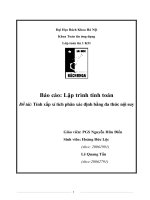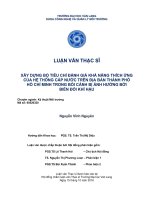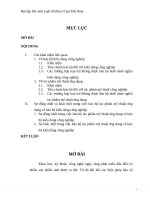PHƯƠNG PHÁP CẦU PHƯƠNG THÍCH ỨNG XẤP XỈ TÍCH PHÂN KÉP TRÊN MIỀN HÌNH CHỮ NHẬT CONG
Bạn đang xem bản rút gọn của tài liệu. Xem và tải ngay bản đầy đủ của tài liệu tại đây (439.7 KB, 6 trang )
<span class='text_page_counter'>(1)</span><div class='page_container' data-page=1>
179
<b>ADAPTIVE QUADRATURE METHOD TO APPROXIMATE DOUBLE </b>
<b>INTEGRALS OVER NON-RECTANGULAR REGIONS </b>
<b>Pham Thi Thu Hang, Dinh Van Tiep* </b>
<i>University of Technology - TNU </i>
ABSTRACT
Recently, in an early publication [1], the author presented an algorithm to approximate double
integral over a rectangle basing on the adaptive quadrature method. This method has the upper
hand comparing with many other approaches due to its low cost and high efficiency. In that paper,
even the algorithm was constructed strictly for approximating double integrals over rectangles
only, it can be also extended to treat the case of rectangular regions. Nevertheless, for
non-rectangular regions, it is not somewhat practical to program such an algorithm because of the
consumption a large amount of RAM to store data of values for functions taking on the boundary
of the region. The storage is performed at many steps in each repeating loop. This shortcoming
often makes the program implement awkwardly. This paper aims to revise the aforementioned
algorithm to be more efficient.
<i><b>Key words: numerical integration, approximate double integral, adaptive method, adaptive </b></i>
<i>quadrature, non-rectangle region.</i>
INTRODUCTION*
Similar to an algorithm for the adaptive
quadrature of double integrals over a
rectangular region, presented in [1], one of
double integral over general regions, or more
exactly, over non-rectangular regions, could
be constructed. Here, we confine the
consideration to such regions bounded by
graphs of functions,
Ω = {(𝑥, 𝑦)|𝑎 ≤ 𝑥 ≤ 𝑏, 𝑐(𝑥) ≤ 𝑦 ≤ 𝑑(𝑥)},
where 𝑐, 𝑑 are functions defined on [𝑎, 𝑏].
Without losing of generality, we can assume
that 𝑐(𝑥) ≤ 𝑑(𝑥), ∀𝑥 ∈ [𝑎, 𝑏], keeping in
mind that the algorithm we are going to
discuss here still works very well if the role of
𝑥 and 𝑦 are switched. We are going to
approximate the double integral
𝐼 = ∬ 𝑓(𝑥, 𝑦)
Ω
𝑑𝐴
of a continuous function 𝑓 defining on Ω. To
apply the adaptive quadrature method which
had been well developed for one variable, we
rewrite the double integral in the form of an
iterated integral
*
<i>Tel: 0888 272060, Email: </i>
𝐼 = ∫ ∫𝑑(𝑥)𝑓(𝑥, 𝑦)𝑑𝑦𝑑𝑥
𝑐(𝑥)
𝑏
𝑎
. (1)
First, fixing 𝑥 in [𝑎, 𝑏], we use the method on
the interval [𝑐(𝑥), 𝑑(𝑥)] of the vertical axis,
and then on the interval [𝑎, 𝑏] of the
horizontal axis. For a given tolerance 𝜀 > 0,
and a given level of subdivision 𝑁, after a
finite number of repetitions of this procedure,
we can decide whether the obtained
approximation meets the requirement or not.
(Failure to meet the requirement is signified
by exceeding the given level of the needed
level of subdivision.)
CONSTRUCTION OF THE METHOD
In this section, we are going to formulate the
theoretical basis for the algorithm. Firstly, set
2𝑝 = ℎ =𝑏 − 𝑎
2 , and functions k, q with
2𝑞(𝑥) = 𝑘(𝑥) =𝑑(𝑥) − 𝑐(𝑥)
2 , ∀𝑥 ∈ [𝑎, 𝑏].
Apply Simpson’s and Composite Simpson’s
Rule with number of nodes 𝑛 = 4,
successively, we get
𝐼 =ℎ
9∑ 𝑛𝑙[∑ 𝑛𝑗𝑘(𝑥𝑗)𝑓(𝑥𝑗, 𝑦𝑙𝑗)
2
𝑗=0
]
2
𝑙=0
− 𝐸̂<sub>1</sub>
</div>
<span class='text_page_counter'>(2)</span><div class='page_container' data-page=2>
180
𝐼 =𝑝
9∑ 𝑚𝑙[∑ 𝑚𝑗𝑞(𝑥𝑗)𝑓(𝑥𝑗, 𝑦𝑙𝑗)
4
𝑗=0
]
4
𝑙=0
− 𝐸̂<sub>2</sub>
=: 𝑆̂ − 𝐸2 ̂ , 2
where 𝑛<sub>0</sub>= 𝑛<sub>2</sub> = 1, 𝑛<sub>1</sub>= 4, and 𝑚<sub>0</sub>= 𝑚<sub>4</sub> =
1, 𝑚<sub>2</sub>= 2, 𝑚<sub>3</sub>= 𝑚<sub>4</sub>= 4. The error estimates
are 𝐸̂ =1
𝑏−𝑎
90 [ℎ4𝑘(𝜂̅)𝑓(𝜂̅, 𝜉̅) + 𝑘5(𝜇̅)
𝜕4<sub>𝑓</sub>
𝜕𝑦4(𝜇̅, 𝛾𝜇̅)], and
𝐸<sub>2</sub>
̂ =<sub>16</sub>1 𝑏−𝑎<sub>90</sub> [ℎ4<sub>𝑘(𝜂̂)</sub>𝜕4𝑓
𝜕𝑥4(𝜂̂, 𝜉̂) +
𝑘4<sub>(𝜇̂)</sub>𝜕4𝑓
𝜕𝑦4(𝜇̂, 𝛾𝜇̂)], for some
(
𝜂̅
, 𝜉̅)
,(
𝜇̅
, 𝛾<sub>𝜇</sub><sub>̅</sub>),
and
(
𝜂̂
, 𝜉̂)
,(
𝜇̂
, 𝛾<sub>𝜇</sub><sub>̂</sub>)
∈ Ω. By assuming that(
𝜂̅
, 𝜉̅)
≈(
𝜂̂
, 𝜉̂)
,(
𝜇̅
, 𝛾<sub>𝜇</sub><sub>̅</sub>)
≈(
𝜇̂
, 𝛾<sub>𝜇</sub><sub>̂</sub>)
, we get𝐸<sub>2</sub>
̂
≈ 116𝐸
̂
1, and|
𝑆̂
2− 𝐼|
≈1
15
|
𝑆̂
2− 𝑆̂ |
1 .Thus, 𝑆̂ estimates 𝐼 about 15 times better <sub>2</sub>
than it agrees with 𝑆̂ . So, if |𝑆<sub>1</sub> ̂ − 𝑆<sub>1</sub> ̂| < 15𝜀, <sub>2</sub>
then that |𝐼 − 𝑆̂| = |∬ 𝑓(𝑥, 𝑦)𝑑𝑥𝑑𝑦<sub>2</sub> <sub>Ω</sub> −
𝑆<sub>2</sub>
̂| < 𝜀 might be accepted confidently. We
can trust that 𝑆̂ is good enough to <sub>2</sub>
approximate 𝐼 within the given tolerance 𝜀.
Conversely, if |𝑆̂ − 𝑆<sub>1</sub> ̂| ≥ 15𝜀, we subdivide <sub>2</sub>
Ω into four smaller pieces by mesh points
𝑎 = 𝑥<sub>0</sub>< 𝑥<sub>1</sub>=𝑎 + 𝑏
2 < 𝑥2 = 𝑏,
𝑐(𝑥) = 𝑦<sub>0</sub>(𝑥) < 𝑦<sub>1</sub>(𝑥) =𝑐(𝑥) + 𝑑(𝑥)
2
< 𝑦<sub>2</sub>(𝑥) = 𝑑(𝑥).
Now, on each piece, we required that the
difference between the corresponding 𝑆̂ , and 1
𝑆2
̂ does not exceed a quarter of 15𝜀. If this
condition is fulfilled, we use this value of
𝑆<sub>2</sub>
̂ as an approximation of the integral over
the considered piece. On the other hand, if
this condition fails to meet, we keep going on
subdividing the considered piece into four
smaller pieces and carry on performing the
above procedure until reaching the target. The
required tolerance is now reduced by a factor
of four from the previous level. For our
algorithm, we repeat the procedure a finite
number of times which guarantees that the
level of subdivision does not exceed 𝑁. If this
demand is undertaken and the procedure
completes, it is successful. By summing up
such approximations all over considered
pieces on which the procedure succeeds, we
obtain a significant approximation for 𝐼. In
the case where the level of subdivision
exceeds 𝑁, we conclude that the whole
procedure fails to meet the demand. To expect
the method can be reapplied successfully on
Ω, we need to reduce the tolerance 𝜀 and/or
increase 𝑁.
ALGORITHM
The above algorithm could be expressed with
the use of a pseudo-code, as follows
<b>INPUT region </b> Ω with 𝑎, 𝑏, 𝑐(𝑥), 𝑑(𝑥),
tolerance 𝜖 > 0, limit 𝑁 to number of levels.
<b>OUTPUT approximation </b>𝐴𝑃 of 𝐼, or message
that 𝑁 is exceeded (the procedure fails).
<b>Step 1 (</b>Initiate the procedure)
𝐴𝑃 ≔ 0; 𝑖 ≔ 0, 𝐿𝑖 ≔ 1; 𝜖𝑖 ≔ 15𝜖; (Here, 𝐿𝑖
indicates the recent level of the subdivision.)
𝑛<sub>0</sub> ≔ 1; 𝑛<sub>1</sub>≔ 4; 𝑛<sub>2</sub><i>≔ 1; (</i>The coefficients in
Simpson’s Rule.)
𝑚0≔ 1; 𝑚1≔ 4; 𝑚2≔ 2; 𝑚3 ≔ 4; 𝑚4≔
1. (The coefficients in Composite Simpson’s Rule.)
𝑟<sub>𝑖</sub> ≔ 1; 𝑠<sub>𝑖</sub>≔ 2𝑁<sub>+ 1; </sub><sub>(The starting and ending </sub>
indices of mesh points traced on [𝑎, 𝑏].)
𝑅<sub>𝑖</sub> ≔ 0; (Initial region 𝛺 is numbered by 0.)
For j from 1 to 2𝑁<sub>+ 1 do </sub>
𝑋<sub>𝑗</sub> ≔ 𝑎 + (𝑗 − 1)𝑏 − 𝑎
2𝑁 ;
𝐹<sub>𝑖</sub>(𝑗) ≔ 𝑐(𝑋𝑗); 𝐺𝑖(𝑗) ≔ 𝑑(𝑋𝑗);
(See the NOTE below for 𝐹𝑖, 𝐺𝑖.)
End do.
<b>Step 2 While </b>𝑖 > 0 do Steps 3-5.
<b>Step 3 </b>
ℎ<sub>𝑖</sub> ≔ 0.5(𝑋𝑠𝑖− 𝑋𝑟𝑖); 𝑡𝑖 ≔ 0.5(𝑠𝑖− 𝑟𝑖);
<b>IF </b>(𝐿<sub>𝑖</sub> ≥ 𝑁) or (ℎ𝑡<sub>𝑖</sub><b> is odd) THEN </b>
<b>OUTPUT (“LEVEL IS EXCEEDED.”); </b>
<b>STOP. </b>
<b>ELSE </b>
For 𝑗 = 1 to 3 do
</div>
<span class='text_page_counter'>(3)</span><div class='page_container' data-page=3>
181
𝑘<sub>𝑖𝑗</sub>≔ 0.5[𝐺<sub>𝑖</sub>(𝑟<sub>𝑖</sub>+ (𝑗 − 1)𝑡<sub>𝑖</sub>) − 𝐹<sub>𝑖</sub>(𝑟<sub>𝑖</sub>
+ (𝑗 − 1)𝑡<sub>𝑖</sub>)];
For 𝑙 = 1 to 3 do
𝑦<sub>𝑙𝑗</sub> ≔ 𝐹<sub>𝑖</sub>(𝑟<sub>𝑖</sub>+ (𝑗 − 1)𝑡<sub>𝑖</sub>) + (𝑙 − 1)𝑘<sub>𝑖𝑗</sub>
End do;
End do; (Set up data of mesh points for Simpson’s
Rule.)
For 𝑗 = 1 to 5 do
𝑧<sub>𝑗</sub>≔ 𝑋<sub>𝑟</sub><sub>𝑖</sub>+ 0.5(𝑗 − 1)ℎ<sub>𝑖</sub>;
𝑝<sub>𝑖𝑗</sub> ≔ 0.25[𝐺<sub>𝑖</sub>(𝑟𝑖+ 0.5(𝑗 − 1)𝑡𝑖) − 𝐹𝑖(𝑟𝑖
+ 0.5(𝑗 − 1)𝑡<sub>𝑖</sub>)];
For 𝑙 = 1 to 5 do
𝑞<sub>𝑙𝑗</sub> ≔ 𝐹<sub>𝑖</sub>(𝑟<sub>𝑖</sub>+ 0.5(𝑗 − 1)𝑡<sub>𝑖</sub>) + (𝑙 − 1)𝑝<sub>𝑖𝑗</sub>;
End do;
End do; (Set up data of mesh points for
Composite Simpson’s Rule.)
𝑆1≔ 0; 𝑆2≔ 0; (Initiate the values for
Simpson’s and Composite Simpson’s Rule,
respectively.)
For 𝑙 = 1 to 3 do
For 𝑗 = 1 to 3 do
𝑆<sub>1</sub> ≔ 𝑆<sub>1</sub>+ℎ𝑖𝑘𝑖𝑗
9 𝑛𝑙𝑛𝑗𝑓(𝑥𝑙, 𝑦𝑙𝑗);
End do; (Simpson’s Rule.)
End do;
For 𝑙 = 1 to 5 do
For 𝑗 = 1 to 5 do
𝑆<sub>2</sub>≔ 𝑆<sub>2</sub>+ℎ𝑖𝑝𝑖𝑗
18 𝑚𝑙𝑚𝑗𝑓(𝑧𝑗, 𝑞𝑙𝑗);
End do; (Composite Simpson’s Rule.)
End do;
𝑢<sub>1</sub>≔ 𝑟<sub>𝑖</sub>; 𝑢<sub>2</sub>≔ 𝑠<sub>𝑖</sub>; 𝑢<sub>3</sub>≔ 𝑡<sub>𝑖</sub>; 𝑢<sub>4</sub>≔ 𝐹<sub>𝑖</sub>;
𝑢<sub>5</sub>≔ 𝐺<sub>𝑖</sub>; 𝑢<sub>6</sub>≔ 𝜖<sub>𝑖</sub>; 𝑢<sub>7</sub>≔ 𝐿<sub>𝑖</sub>. (Save data.)
𝑙𝑒𝑣𝑒𝑙<sub>𝑖</sub>≔ 𝑢<sub>7</sub>; (The variable 𝑙𝑒𝑣𝑒𝑙 stores the
sequence of operating levels in whole procedure.)
If 𝑠𝑖𝑧𝑒(𝑙𝑒𝑣𝑒𝑙) > 1 then
𝑐𝑜𝑢𝑛𝑡 ≔ 0; 𝑗 ≔ 1; (Initiate counting pieces of
the same level with the current level.)
while 𝑗 ≤ 𝑠𝑖𝑧𝑒(𝑙𝑒𝑣𝑒𝑙) − 1 do
if 𝑙𝑒𝑣𝑒𝑙𝑗= 𝑙𝑒𝑣𝑒𝑙𝑠𝑖𝑧𝑒(𝑙𝑒𝑣𝑒𝑙) then
𝑐𝑜𝑢𝑛𝑡 ≔ 𝑐𝑜𝑢𝑛𝑡 + 1;
end if; 𝑗 ≔ 𝑗 + 1;
end do; 𝑅<sub>𝑖</sub> ≔ 4 − 𝐦𝐨𝐝(𝑐𝑜𝑢𝑛𝑡, 4);
End if.
<b>Step 4 </b>𝑖: = 𝑖 − 1. (Delete the level.)
<b>Step 5 If |</b>𝑆2− 𝑆1| < 𝑢6<b> then </b>
𝐴𝑃 ≔ 𝐴𝑃 + 𝑆<sub>2</sub>; 𝑠𝑡𝑎𝑡𝑢𝑠<sub>𝑖</sub> ≔ "PASS".
(Variable 𝑠𝑡𝑎𝑡𝑢𝑠 is used to store the sequence of
results revealed when performing the procedure
on each piece of the region.)
<b>Else </b>(Add one level.) 𝑠𝑡𝑎𝑡𝑢𝑠𝑖<b>≔ "FAIL"; </b>
𝑖 ≔ 𝑖 + 1; (Data for region 𝑅1, cf. Figure 1.)
𝑟𝑖 ≔ 𝑢1; 𝑠𝑖 ≔ 𝑢1+ 𝑢3; 𝐹𝑖 ≔ 𝑢4;
𝐺<sub>𝑖</sub> ≔ 0.5(𝑢<sub>4</sub>+ 𝑢<sub>5</sub>); 𝜖𝑖 ≔
𝑢<sub>6</sub>
4 ; 𝐿𝑖 ≔ 𝑢7+ 1.
𝑖 ≔ 𝑖 + 1; (Data for region 𝑅2.)
𝑟𝑖 ≔ 𝑢1; 𝑠𝑖 ≔ 𝑢1+ 𝑢3; 𝐹𝑖 ≔ 𝐺𝑖−1; 𝐺𝑖≔ 𝑢5;
𝜖𝑖 ≔ 𝜖𝑖−1; 𝐿𝑖 ≔ 𝐿𝑖−1;
𝑖 ≔ 𝑖 + 1; (Data for region 𝑅3.)
𝑟<sub>𝑖</sub> ≔ 𝑢<sub>1</sub>+ 𝑢<sub>3</sub>; 𝑠<sub>𝑖</sub> ≔ 𝑢<sub>2</sub>; 𝐹<sub>𝑖</sub> ≔ 𝑢<sub>4</sub>;
𝐺<sub>𝑖</sub> ≔ 0.5(𝑢<sub>4</sub>+ 𝑢<sub>5</sub>); 𝜖𝑖 ≔ 𝜖𝑖−1; 𝐿𝑖 ≔ 𝐿𝑖−1;
𝑖 ≔ 𝑖 + 1; (Data for region 𝑅4.)
𝑟<sub>𝑖</sub> ≔ 𝑢<sub>1</sub>+ 𝑢<sub>3</sub>; 𝑠<sub>𝑖</sub> ≔ 𝑢<sub>2</sub>; 𝐹<sub>𝑖</sub>≔ 𝐺<sub>𝑖−1</sub>; 𝐺<sub>𝑖</sub> ≔ 𝑢<sub>5</sub>;
𝜖𝑖 ≔ 𝜖𝑖−1; 𝐿𝑖 ≔ 𝐿𝑖−1.
<b>End if. </b>
<b>END IF. </b>
<b>Step 6 </b>
<b>OUTPUT </b>𝐴𝑃, and 𝑅𝑖, 𝑙𝑒𝑣𝑒𝑙𝑖, 𝑠𝑡𝑎𝑡𝑢𝑠𝑖.
<b>STOP. </b>
<b>NOTE: </b> 𝐹𝑖, 𝐺𝑖 are used in place of the
functions 𝑐, 𝑑 in order to reduce essentially
the memory for storing data of values for
<i>functions at the corresponding step i because </i>
the data of 𝐹<sub>𝑖</sub>, 𝐺<sub>𝑖</sub> are finite vectors instead of
continuum ones for continuous functions.
This technique improves dramatically the
efficiency of the method comparing to one
mentioned in [1].
EXAMPLES
Basing on the pseudo-code, one can easily
edit a code with a help of a plenty of powerful
software. The examples presented in this
paper are ones experimented with code
designed for implementing on Matlab R2017a
and Maple 2016.
</div>
<span class='text_page_counter'>(4)</span><div class='page_container' data-page=4>
182
𝐼 = ∬ 2𝑥
𝑥2<sub>+ 𝑦 + 1</sub>𝑑𝐴
Ω={(𝑥,𝑦)|−1≤𝑦≤3,1≤𝑥≤3}
,
with the tolerance 𝜖 = 0.0004, and the
number of limit level 𝑁 = 5.
The procedure applied for this example in fact
is one presented in [1], where functions
𝑐(𝑥) ≡ −1, 𝑑(𝑥) ≡ 3 are constants. The
algorithm in this paper is more general than
one presented in [1]. The obtained
approximation is 𝐴𝑃 = 5.522168791. The
exact value of the integral is 𝐼 = 13 ln 13 −
18 ln 3 − 5 ln 5 ≈ 5.52213.
The procedure is described by the sequences
𝑅𝑖, 𝑙𝑒𝑣𝑒𝑙𝑖 and 𝑠𝑡𝑎𝑡𝑢𝑠𝑖 released from the
algorithm. They are shown in Table 1.
<b>Table 1. </b>
𝑙𝑒𝑣𝑒𝑙𝑖 𝑅𝑖 𝑠𝑡𝑎𝑡𝑢𝑠𝑖 𝑙𝑒𝑣𝑒𝑙𝑖 𝑅𝑖 𝑠𝑡𝑎𝑡𝑢𝑠𝑖
1 0 FAIL 3 4 FAIL
2 4 PASS 3 3 PASS
2 3 PASS 3 2 PASS
2 2 PASS 3 1 PASS
2 1 FAIL
We are going to interpret data in Table 1.
Initiated with the level 𝑙𝑒𝑣𝑒𝑙<sub>𝑖</sub> = 1, and the
original region Ω indicated by 𝑅<sub>𝑖</sub> = 0, the
procedure fails to meet the requirement. This
conclusion is identified by the value
𝑠𝑡𝑎𝑡𝑢𝑠𝑖 = 𝐹𝐴𝐼𝐿. Then, next step, Ω is
partitioned into 4 smaller rectangles, this
implementation is indicated by the increased
value 𝑙𝑒𝑣𝑒𝑙𝑖 up to 2. The procedure is
reapplied on one of such rectangles, which is
numbered by 𝑅<sub>𝑖</sub> = 4, the results is
represented by the value 𝑠𝑡𝑎𝑡𝑢𝑠<sub>𝑖</sub> = 𝑃𝐴𝑆𝑆.
Next, the procedure is reapplied again on
another subrectangle numbered by 𝑅𝑖 = 3 of
the same level 𝑙𝑒𝑣𝑒𝑙<sub>𝑖</sub> = 2. This produces an
acceptable result indicated by the value
𝑠𝑡𝑎𝑡𝑢𝑠<sub>𝑖</sub> = 𝑃𝐴𝑆𝑆. And so on, the last
performance is undertaken at 𝑙𝑒𝑣𝑒𝑙𝑖 = 3, on
subrectangle numbered 1 of the subrectangle
1 obtained at 𝑙𝑒𝑣𝑒𝑙𝑖 = 2. The ending 𝑙𝑒𝑣𝑒𝑙𝑖 =
3 does not exceed the limit level 𝑁 tells us
that the procedure completes successfully.
The process and the graph of the function 𝑓
are illustrated in Figure 2.
<b>Example 2 Approximate the integral </b>
𝐼 = ∬ (𝑥2<sub>+ 2𝑥𝑦)𝑑𝐴</sub>
Ω={(𝑥,𝑦)|𝑥2<sub>≤𝑦≤𝑥,0≤𝑥≤1}</sub>
,
with 𝜖 = 10−5<sub>, 𝑁 = 5. </sub>
The obtained result 𝐴𝑃 = 0.1333283695 is
significant to estimate 𝐼 to within 10−5.
Indeed, it is very simple to see that 𝐼 =<sub>15</sub>2 =
0.1(3). Other information about the
performance of the procedure applied on Ω is
contained in sequences 𝑅𝑖, 𝑙𝑒𝑣𝑒𝑙𝑖, and
𝑠𝑡𝑎𝑡𝑢𝑠<sub>𝑖</sub> which are released along with 𝐴𝑃.
Table 2 tells us the complete process. The
graph of the function 𝑓 is shown in Figure 3.
<b>Table 2. </b>
𝑙𝑒𝑣𝑒𝑙𝑖 𝑅𝑖 𝑠𝑡𝑎𝑡𝑢𝑠𝑖 𝑙𝑒𝑣𝑒𝑙𝑖 𝑅𝑖 𝑠𝑡𝑎𝑡𝑢𝑠𝑖
1 0 FAIL 3 2 PASS
2 4 FAIL 3 1 FAIL
3 4 PASS 4 4 PASS
3 3 PASS 4 3 PASS
3 2 PASS 4 2 PASS
3 1 PASS 4 1 PASS
2 3 FAIL 2 2 FAIL
3 4 FAIL 3 4 PASS
4 4 PASS 3 3 PASS
4 3 PASS 3 2 PASS
4 2 PASS 3 1 PASS
4 1 PASS 2 1 FAIL
3 3 FAIL 3 4 PASS
4 4 PASS 3 3 PASS
4 3 PASS 3 2 PASS
4 2 PASS 3 1 PASS
</div>
<span class='text_page_counter'>(5)</span><div class='page_container' data-page=5>
183
SUMMARY
Storing only data for a vector rather than data
of values for a function reduces dramatically
the memory of the computer in implementing
an algorithm. This technique is pretty much
suitable for the algorithm developed. A
further extension for this algorithm on higher
dimensions with the use of the technique is
hopefully expected to be a useful and efficient
algorithm in a future paper.
REFERENCES
1. Dinh Van Tiep (2017), “An algorithm to
approximate double integrals by using adaptive
<i>quadrature method”, Journal of Sciences and </i>
<i><b>Technology, TNU, 176(16), pp 121-126. </b></i>
2. Richard L. Burden, J. Douglas Faires (2010),
<i>Numerical Analysis, 9</i>th<b> Edition, Brooks/Cole. </b>
3. William M. McKeeman (1962), “Algorithm
145: Adaptive numerical integration by Simpson's
rule”. Commun. ACM 5(12), pp 604.
4. John R. Rice (1975), “A Metalgorithm for
<i>Adaptive Quadrature”. Journal of the ACM, </i>
22(1), pp 61-8.
TÓM TẮT
<b>PHƯƠNG PHÁP CẦU PHƯƠNG THÍCH ỨNG XẤP XỈ TÍCH PHÂN KÉP </b>
<b>TRÊN MIỀN HÌNH CHỮ NHẬT CONG </b>
<b>Phạm Thị Thu Hằng, Đinh Văn Tiệp*</b>
<i>Trường Đại học Kỹ thuật Công nghiệp – ĐH Thái Nguyên </i>
Mới đây, trong bài báo [1], tác giả đã giới thiệu một thuật toán xấp xỉ tích phân kép trên miền hình
chữ nhật dựa trên phương pháp cầu phương thích ứng. Phương pháp này tỏ ra vượt trội hơn các
phương pháp cầu phương khác bởi chi phí thấp song hiệu quả cao. Trong bài báo [1], mặc dù thuật
toán chỉ được xây dựng cụ thể và chặt chẽ cho tích phân kép trên miền hình chữ nhật, nhưng nó có
thể được mở rộng sang trường hợp của miền hình chữ nhật cong. Tuy nhiên, với miền hình chữ
nhật cong, một chương trình được lập trình dựa trên thuật tốn đó sẽ khá rườm rà bởi việc sử dụng
một dung lượng lớn RAM máy tính để lưu trữ dữ liệu về giá trị hàm số trên biên của miền. Việc
lưu trữ này được thực hiện trong nhiều bước tại mỗi vòng lặp. Điều này khiến chương trình thực
thi chậm chạp, độ chính xác thấp. Bài báo này sẽ đưa ra giải pháp khắc phục một cách hiệu quả
nhược điểm này.
<i><b>Từ khóa: tích phân số, xấp xỉ tích phân kép, phương pháp thích ứng, cầu phương thích ứng, miền </b></i>
<i>hình chữ nhật cong. </i>
<i><b>Ngày nhận bài: 27/4/2018; Ngày phản biện: 23/5/2018; Ngày duyệt đăng: 31/5/2018</b></i>
*
</div>
<span class='text_page_counter'>(6)</span><div class='page_container' data-page=6></div>
<!--links-->









